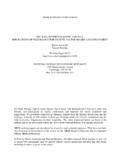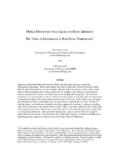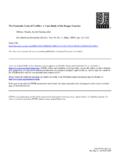Transcription of Skills, Tasks and Technologies: Implications for ...
1 NBER WORKING PAPER SERIESSKILLS, Tasks AND technologies : Implications FOR EMPLOYMENT AND EARNINGSD aron AcemogluDavid AutorWorking Paper 16082 BUREAU OF ECONOMIC RESEARCH1050 Massachusetts AvenueCambridge, MA 02138 June 2010We thank Amir Kermani for outstanding research assistance and Melanie Wasserman for persistent,meticulous and ingenious work on all aspects of the chapter. We are indebted to Arnaud Costinot andDavid Dorn for insightful comments and suggestions, and to David Dorn, Nicole Fortin, and MaartenGoos for generous assistance with data. Autor acknowledges support from the National Science Foundation(CAREER award SES-0239538).The views expressed herein are those of the authors and do not necessarilyreflect the views of the National Bureau of Economic working papers are circulated for discussion and comment purposes.
2 They have not been peer-reviewed or been subject to the review by the NBER Board of Directors that accompanies officialNBER publications. 2010 by daron acemoglu and David Autor. All rights reserved. Short sections of text, not to exceedtwo paragraphs, may be quoted without explicit permission provided that full credit, including notice,is given to the , Tasks and technologies : Implications for Employment and EarningsDaron Acemoglu and David AutorNBER Working Paper No. 16082 June 2010 JEL No. J20,J23,J24,J30,O31,O33 ABSTRACTA central organizing framework of the voluminous recent literature studying changes in the returnsto skills and the evolution of earnings inequality is what we refer to as the canonical model, whichelegantly and powerfully operationalizes the supply and demand for skills by assuming two distinctskill groups that perform two different and imperfectly substitutable Tasks or produce two imperfectlysubstitutable goods.
3 Technology is assumed to take a factor-augmenting form, which, by complementingeither high or low skill workers, can generate skill biased demand shifts. In this paper, we argue thatdespite its notable successes, the canonical model is largely silent on a number of central empiricaldevelopments of the last three decades, including: (1) significant declines in real wages of low skillworkers, particularly low skill males; (2) non-monotone changes in wages at different parts of theearnings distribution during different decades; (3) broad-based increases in employment in high skilland low skill occupations relative to middle skilled occupations ( , job 'polarization'); (4) rapid diffusionof new technologies that directly substitute capital for labor in Tasks previously performed by moderately-skilled workers.
4 And (5) expanding offshoring opportunities, enabled by technology, which allow foreignlabor to substitute for domestic workers in specific Tasks . Motivated by these patterns, we argue thatit is valuable to consider a richer framework for analyzing how recent changes in the earnings andemployment distribution in the United States and other advanced economies are shaped by the interactionsamong worker skills, job Tasks , evolving technologies , and shifting trading opportunities. We proposea tractable task-based model in which the assignment of skills to Tasks is endogenous and technicalchange may involve the substitution of machines for certain Tasks previously performed by labor. Wefurther consider how the evolution of technology in this task-based setting may be endogenized.
5 Weshow how such a framework can be used to interpret several central recent trends, and we also suggestfurther directions for empirical AcemogluDepartment of EconomicsMIT, E52-380B50 Memorial DriveCambridge, MA 02142-1347and CIFARand also AutorDepartment of EconomicsMIT, E52-37150 Memorial DriveCambridge, MA 02142-1347and changes in the distribution of earnings and the returns to college over the last several decades inthe labor market have motivated a large literature investigating the relationship between technicalchange and wages. The starting point of this literature is the observation that the return to skills, forexample as measured by the relative wages of college graduate workers to high school graduates, hasshown a tendency to increase over multiple decades despite the large secular increase in the relativesupply of college educated workers.
6 This suggests that concurrent with the increase in the supply ofskills, there has been an increase in the (relative) demand for skills. Following Tinbergen s pioneering(1974, 1975) work, the relative demand for skills is then linked to technology, and in particular to theskill biasof technical change. This perspective emphasizes that the return to skills (and to college)is determined by a race between the increase in the supply of skills in the labor market and technicalchange, which is assumed to be skill biased, in the sense that improvements in technology naturallyincrease the demand for more skilled workers, among them, college graduates (relative to non-collegeworkers).These ideas are elegantly and powerfully operationalized by what we refer to as thecanonical model,which includes two-skill groups performing two distinct and imperfectly substitutable occupations (orproducing two imperfectly substitutable goods).
7 1 Technology is assumed to take afactor-augmentingform, and thus complements either high or low skill workers. Changes in this factor-augmentingtechnology then capture skill biased technical canonical model is not only tractable andconceptually attractive, but it has also proved to be empirically quite successful. Katz and Murphy(1992), Autor Katz and Krueger (1998), Autor, Katz and Kearney (2008), and Carneiro and Lee(2009), among others, show that it successfully accounts for several salient changes in the distributionof earnings in the United States. Katz, Loveman, and Blanchflower (1995), Davis (1992) and Murphy,Riddell and Romer (1998), Card and Lemieux (2001a), Fitzenberger and Kohn (2006), Atkinson(2008) among others, show that the model also does a good job of capturing major cross-countrydifferences among advanced nations.
8 Goldin and Katz (2008) show that the model, with some minormodifications, provides a good account for the changes in the returns to schooling and the demandfor skills throughout the entire twentieth century in the United this paper, we argue that despite the canonical model s conceptual virtues and substantialempirical applicability, a satisfactory analysis of modern labor markets and recent empirical trends1In many cases, this model is extended to more than twoskill groups (see., , Card and Lemieux, 2001, andAcemoglu, Autor and Lyle, 2004. Atkinson (2008) refers to the Tinbergen education-race model as the Textbook addition to Tinbergen (1974, 1975), see Welch (1973), Freeman (1976), Katz and Murphy (1992) and Autor, Katzand Krueger (1998), and Autor, Katz and Kearney (2008) on the canonical model.)
9 Acemoglu (2002a) develops severalimplications of the canonical model andrelates these to other approaches to the relationship between technology andskill a richer framework. We emphasize two shortcomings of the canonical model. First, thecanonical model is made tractable in part because it does not include a meaningful role for Tasks , or equivalently, it imposes a one-to-one mapping between skills and Tasks . Ataskis a unit of workactivity that produces output (goods and services). In contrast, a skill is a worker s endowment ofcapabilities for performing various Tasks . Workers apply their skill endowments to Tasks in exchangefor wages, and skills applied to Tasks produce output. The distinction between skills and Tasks becomesparticularly relevant when workers of a given skill level can perform a variety of Tasks and change theset of Tasks that they perform in response to changes in labor market conditions and technology.
10 Weargue that a systematic understanding of recent labor market trends, and more generally of the impactof technology on employment and earnings, requires a framework that factors in such changes in theallocation of skills to Tasks . In particular, we suggest, following Autor, Levy and Murnane (2003),that recent technological developments have enabled information and communication technologies toeither directly perform or permit the offshoring of a subset of the core job Tasks previously performedby middle skill workers, thus causing a substantial change in the returns to certain types of skills anda measurable shift in the assignment of skills to , the canonical model treats technology as exogenous and typically assumes that technicalchange is, by itsnature, skill biased.













